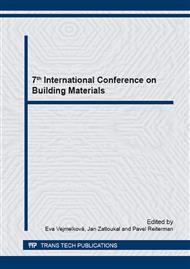[1]
H. Okamura, M. Ouchi, Self-compacting concrete, development, present use and future. In: Proceedings of the RILEM Symposium on Self-Compacting Concrete, Skarendahl A., Petersson O. (eds. ). RILEM Publications S.A.R.L., Stockholm 1999, pp.15-21.
DOI: 10.1007/bf02484169
Google Scholar
[2]
M. Nilsson, O. Petersson, The first bridge made of SCC. Vaeg- och Vattenbyggaren 2 (1998), 28-31.
Google Scholar
[3]
B. Persson, Mix proportions and strength of SCC for production of high strength poles, piles and pillars. In: 1. Muenchener Baustoffseminar Selbstverdichtiger Beton, Schiessl P. (ed. ). TUM, Munich 2001, pp.31-39.
Google Scholar
[4]
L. Soederlind, Full-scale tests of SCC for dwelling houses. In: In: Proceedings of the RILEM Symposium on Self-Compacting Concrete, Skarendahl A., Petersson O. (eds. ). RILEM Publications S.A.R.L., Stockholm 1999, pp.723-728.
Google Scholar
[5]
H. Okamura, K. Ozawa, Mix Design for Self-Compacting Concrete. Concrete Library of JSCE, 1995, No. 25.
Google Scholar
[6]
K. Takada, G.I. Pelova, J.C. Walraven, Self-Compacting Concrete Produced by Japanese Method with Dutch Materials. Congress of European Ready Mixed Concrete Organization, ERMCO 98, Lisabon, (1998).
Google Scholar
[7]
K. Holschemacher, Bemessungsrelevante Eigenschaften von selbstverdichtenden Betonen, w Selbstverdichtender Beton, 2001, s. 129-143, Eds. G. König, K. Holschemacher, F. Dehn, Bauwerk Verlag GmbH, Berlin.
DOI: 10.1002/best.200201460
Google Scholar
[8]
E. Vejmelková, M. Pavlíková, Z. Keršner, Rovnaníková, M. Ondráček, M. Sedlmajer a R. Černý, High performance concrete containing lower slag amount: A complex view of mechanical and durability properties. Construction and Building Materials. 2009, vol. 23, issue 6, s. 2237-2245.
DOI: 10.1016/j.conbuildmat.2008.11.018
Google Scholar
[9]
ČSN EN 12390-3 Testing of hardened concrete – Part 3: Compressive strength. Czech Standardization Institute, Prague, (2002).
Google Scholar
[10]
ČSN 72 7031: Determination of water vapour diffusion coefficient of building materials by method without temperature gradient, (2001).
Google Scholar


